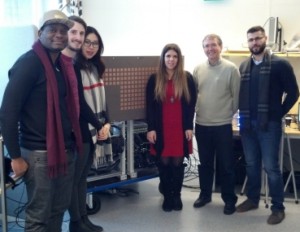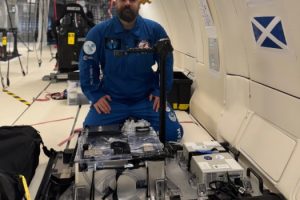Multiple antenna technology, referred to as MIMO, is already used in many Wi-Fi routers and 4G cellular phone systems. Normally this involves up to four antennas at a base station.
The Bristol researchers have created a massive MIMO configuration with 128 antennas deployed at the basestation.
The set-up was created using a prototyping platform from NI based on LabVIEW system design software and PXI hardware. The hardware behind this demonstration was provided to Bristol University as part of the Bristol Is Open programmable city infrastructure.
Lund University in Sweden has a similar setup, the LuMaMi testbed, and researchers at both sites worked in parallel with their development.
Bristol Is Open, a joint venture between Bristol City Council and the University of Bristol, is a research infrastructure to explore developments in software, hardware and telecom networks that enable more interaction between people and places and more machine-to-machine communication.
Bristol’s Massive MIMO system used for the demo, to test spectrum efficiency, operates at a carrier frequency of 3.5GHz and supports simultaneous wireless connectivity to up to 12 single antenna clients. Each client shares a common 20MHz radio channel. Complex digital signal processing algorithms unravel the individual data streams in the space domain seen by the antenna array.
The Massive MIMO demonstration was conducted in the atrium of Bristol’s Merchant Venturers Building and achieved an unprecedented bandwidth efficiency of 79.4bit/s/Hz. This equates to a sum rate throughput of 1.59Gbit/s in a 20MHz channel.
Ove Edfors, Professor of Radio Systems at Lund University says:
“We see massive MIMO as the most promising 5G technology and we have pushed it forward together with partners in Bristol and in our EU project MAMMOET. It is a pleasure seeing those efforts materialise.”
Mark Beach, Professor of Radio Systems Engineering in the Department of Electrical & Electronic Engineering and Manager of the EPSRC Centre for Doctoral Training (CDT) in Communications, said:
“Massive MIMO is one of four core activities in ‘5G and beyond’ wireless research at Bristol. This demonstration was made possible by the cohort training offered within our CDT in Communications. The CDT gives Bristol a unique edge to conduct activities at scale.”
The collaborative research project with Lund University and National Instruments included five Bristol based PhD students under the collective guidance of five academic supervisors. In Lund seven PhD students and six supervisors contributed, making it a huge interdisciplinary research effort.
Paul Harris, PhD student in Bristol, explained:
“My PhD training at Bristol alongside a two-month secondment at NI (Austin) put me in a unique position to use this cutting-edge equipment and support my fellow postgraduates with their state-of-the-art research in next generation wireless.”
 Electronics Weekly
Electronics Weekly




